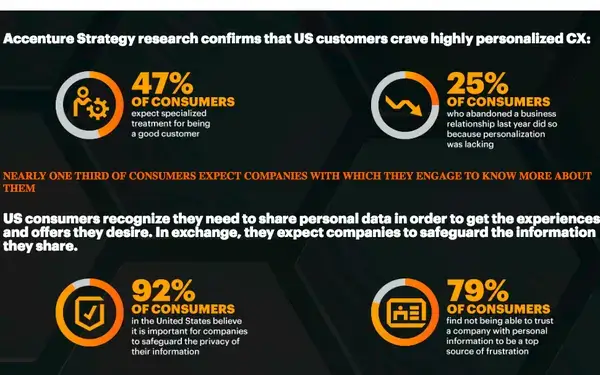Consumers want personalization – they know others use their data and expect it to result in relevant, helpful content. How much and what kind of personalized content do you use in your digital marketing strategies?
But when personalization feels excessive or intrusive, it quickly becomes a turn-off.
Shortcuts:
An Accenture report underscores this tension: 66% of consumers demand transparency about how their data is being used, and 47% expect personalized treatment for their loyalty.

The challenge for us in digital marketing is clear.
We must navigate the fine line between effective personalization that fosters customer engagement and overstepping boundaries, which can erode trust and alienate our audience.
Let's find that balance, ensuring our marketing resonates with informed, discerning consumers without compromising their comfort and trust.
What is Personalization in Digital Marketing?
Personalized marketing, at its core, is a strategy that leverages customer data to tailor a brand's message to individual consumers.
This approach hinges on understanding customers' interests, demographics, and purchasing behaviors.
By utilizing such data, personalized marketing aims to create a sense of exclusivity and direct connection, making each customer feel as though the message is specifically for them.
Often referred to as one-to-one or individual marketing, this technique transcends generic advertising, fostering a more intimate and relevant dialogue between the brand and its consumers.
It's about delivering the right message to the right person at the right time, turning ordinary interactions into unique, personalized experiences.
How Much Personalization is Too Much?
Research by Forrester reveals a startling insight:
71% of adults in the US are aware of apps and websites collecting their data, yet 65% find tracking users across platforms inappropriate for ad customization.
This sentiment reflects a growing discomfort with excessive personalization efforts, especially when they border on intrusion.
For instance, consider the all-too-common experience of browsing for an item, like a pair of trousers, only to abandon the cart.
The relentless appearance of ads for the same trousers across various digital platforms can feel like an invasion of privacy.
It transforms a simple online activity into an unnerving experience reminiscent of a dystopian narrative.
This scenario highlights the fine line between effective personalization and over-personalization.
Machine learning and advanced algorithms might make tracking and targeting with unprecedented precision possible, but they also risk tipping the scale from excellent to creepy.
The key to striking the right balance in our personalization efforts lies in understanding this delicate boundary.
The goal should be to create an exceptional customer experience that respects privacy and preferences rather than one that feels like a relentless pursuit.
When Data Personalization Goes Wrong

Delivering personalized interactions, leveraging purchase history, and fostering customer loyalty, even the most well-intentioned personalized marketing strategies can sometimes fail to reach the mark.
-
Irrelevant recommendations
A classic misstep in personalized marketing is irrelevant product recommendations.
Imagine a customer purchases a winter coat online and then receives a follow-up email suggesting cat or pet feed – a completely unrelated product.
Effective personalization should offer complementary items, like gloves, hats, or scarves, enhancing the shopping experience and reinforcing customer loyalty, not bewildering them with unrelated suggestions.
-
High frequency of retargeting ads
Retargeting ads can be a powerful tool in personalized marketing, but there's a fine line to tread. Bombarding customers with constant reminders of a product they glanced at can be overwhelming.
It's vital to cap the number of impressions to avoid inundating and frustrating potential customers.
Knowing when to pull back and focus on acquiring new customers instead of over-targeting the existing ones is crucial for maintaining a positive brand image.
-
Loss of privacy
A well-known example of personalization going too far involves Target's use of customer data to predict pregnancies.
In one notable case, a teenage girl received targeted ads for baby products before her parents were aware she was pregnant.
This incident highlights a critical aspect of personalized marketing – balancing data utilization with respect for individual privacy.
Overstepping this boundary can lead to a breach of trust and potential damage to customer relationships.
Examples of Creepy Marketing
Delivering personalized interactions based on purchase history for enhanced customer satisfaction is common.
However, when does this pursuit of personalized experiences cross creepy? Let's examine some examples where companies may have stepped over this line.
-
Target

Target's use of customer data to predict significant life events like pregnancy has been lauded and criticized.
By analyzing changes in purchase patterns – such as buying cocoa butter lotion for the first time – Target assigns a "pregnancy prediction" score.
If this score is triggered, the customer might receive special offers on baby products.
This practice garnered media attention when a father discovered his daughter's pregnancy through Target's marketing before she had disclosed it.
Such incidents pose essential questions about balancing personalized marketing and privacy invasion.
-
Netflix

Netflix, a giant in the streaming world, faced backlash for a tweet suggesting their in-depth knowledge of users' viewing habits.
While meant humorously, this tweet revealed the extent of Netflix's data usage.
The company's ability to track and suggest content is crucial for customer engagement.
Still, this incident highlighted a discomfort among some users about the level of personalization, raising concerns about privacy and the ethics of using customer data for marketing.
-
Alphonso
Alphonso, a software used in numerous apps, employs a controversial method for personalized marketing: smartphone microphones to listen for TV ad signals.
This data, indicating user behavior and preferences, is sold to advertisers for more targeted marketing.
The New York Times report on this practice raised significant privacy concerns, as many users are unaware they have consented to such tracking.
This case exemplifies the thin line between creating personalized experiences and infringing on personal privacy, especially when consent is buried in lengthy terms and conditions.
Is Personalization Detrimental to Customer Engagement and Experience?
Despite some unsettling examples of over-personalization, Personalization is crucial in marketing for enhancing customer engagement and experience.
It offers measurable financial advantages:
- Financial Upside: Accenture estimates the potential upside for companies using personalized marketing at $2.95 trillion industry-wide.
- Consumer Preferences: A Salesforce survey reveals
- 52% of consumers will switch brands if communications aren't personalized.
- 62% find personalized offers based on previous purchases acceptable.
Nowadays, consumers expect personalized experiences. Failing to provide this can be a disadvantage against competitors.
The challenge for marketers is to balance customizing the customer journey with respecting their privacy.
Utilizing customer journey software effectively can help in achieving this balance.
The objective is not just personalization for its own sake but creating a tailored experience that respects the customer's boundaries, enhancing their overall brand experience.
Final Thoughts
Personalization in digital marketing is essential for enhancing customer engagement and experience, but it must be approached carefully.
The key takeaways include the significant financial benefits of personalized marketing, with a potential industry upside of $2.95 trillion as per Accenture, and consumer preferences leaning heavily towards personalized interactions.
However, examples of over-personalization underscore the need for a balanced approach.
The challenge for marketers lies in offering tailored experiences that respect privacy and avoid intrusiveness, ensuring personalization is a tool for connection rather than alienation.
Author Bio:
Christian Krink, founder of Vollgas-Marketing, excels in digital marketing, web design, and craft sector recruitment.
He's dedicated to driving success for German SMEs in the digital landscape.


